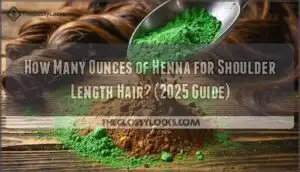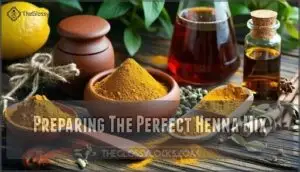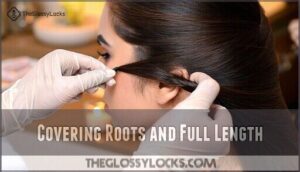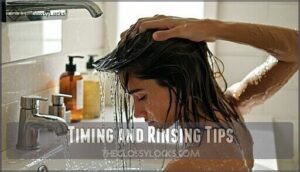This site is supported by our readers. We may earn a commission, at no cost to you, if you purchase through links.

For shoulder-length hair, you’ll generally need 3.5 to 5 ounces of henna powder, but that number shifts based on your hair’s thickness, texture, and how thirsty it is for color. Getting the measurement right means no waste, no panic mid-application, and color that actually covers every strand evenly from root to tip.
Table Of Contents
- Key Takeaways
- How Many Ounces of Henna for Shoulder Length Hair?
- What Factors Affect Henna Quantity?
- How to Measure Henna Powder Accurately
- Preparing The Perfect Henna Mix
- Step-by-Step Henna Application for Shoulder Length Hair
- Henna Hair Care and Color Maintenance
- Frequently Asked Questions (FAQs)
- How long does henna last on shoulder-length hair?
- Is henna safe for all hair types?
- How often should henna be applied to shoulder-length hair?
- Will henna damage my hair?
- Can henna permanently stain my skin or scalp?
- How long should henna paste sit before applying?
- Does henna work on chemically treated or bleached hair?
- Can I mix henna with regular commercial hair dye?
- Whats the shelf life of unopened henna powder?
- Conclusion
Key Takeaways
- You’ll need 3.5 to 5 ounces of henna powder for shoulder-length hair, with the exact amount depending on your hair’s thickness, texture, and porosity rather than length alone.
- Thick or coarse hair can require up to 300 grams (triple the standard amount), while fine hair may need only 100-150 grams, making accurate measurement with a kitchen scale essential for even coverage.
- Mix henna to a thick yogurt consistency using about 1 cup of liquid per 100 grams of powder, and let it sit 4-8 hours before application to allow proper dye release.
- Henna color lasts 4-6 weeks on shoulder-length hair when you skip sulfate shampoos, limit heat styling, wait 48 hours before washing, and apply weekly oil treatments to seal in vibrancy.
How Many Ounces of Henna for Shoulder Length Hair?
You need the right amount of henna to get even coverage without running short halfway through. The amount depends on your hair’s thickness and texture, not just length.
Here’s how much to prep for different hair types.
Standard Henna Powder Measurements
Most henna packages recommend about 3.5 ounces (100 grams) of powder for shoulder-length hair, which works out to roughly 8 tablespoons if you’re measuring by volume.
When measuring henna powder, keep these points in mind:
- Package size matters – Standard henna packages contain 100-150 grams, so you’ll use most of one package.
- Grams vs ounces – A kitchen scale helps convert measurements accurately since powder density varies between batches.
- Measuring tools – Two tablespoons equals roughly 25 grams of henna powder.
Getting the right amount of henna comes down to measuring carefully each time you mix it.
Adjusting for Hair Thickness and Texture
Your hair thickness and texture shift how much henna powder you’ll actually need. Thick or curly hair at shoulder length can require 300 grams or more—triple what thin, straight hair needs at just 100-150 grams. Coarse hair texture demands about 30% extra henna powder for even color saturation compared to fine strands.
Hair porosity matters too; high-porosity hair absorbs henna faster, using 20% less powder than low-porosity types. Mix a thicker paste for coarse hair to boost coverage by another 15%. For best results, follow the henna application process.
Converting Grams to Ounces and Tablespoons
Once you know how much henna powder you need, converting those measurements helps you work with whatever tools you have in your kitchen. 100 grams equals 3.5 ounces—the standard recipe for shoulder-length hair.
You can also use measuring spoons: two tablespoons of powder equals roughly 25 grams. A kitchen scale gives you measurement precision, but spoons work when you adjust for density. Henna powder settles differently than flour, so gently scoop without packing.
How Density Affects Quantity Needed
Your hair’s density—how many strands actually grow from your scalp—changes the game more than length alone. Dense hair needs more henna powder for full scalp coverage. Fine strands may need only 3 ounces, while thick, layered hair could require 5 ounces.
Visual estimation helps: if you can’t see your scalp through your hair, add extra. Hair strand thickness and porosity considerations also affect how much henna hair dye your hair drinks up.
What Factors Affect Henna Quantity?
Figuring out how much henna you need goes beyond just scooping powder into a bowl. Your hair—its texture, length, thickness—actually determines what you’re working with.
Three main factors drive how much henna you’ll actually need.
Hair Thickness and Volume
Think of strand diameter and density as the blueprint for your henna shopping list. Thick hair with a diameter over 0.08 mm needs about 25% more henna powder than fine strands. If you have high density—over 1,200 hairs per square inch—you’ll likely need 4 to 4.5 ounces for shoulder-length hair.
Henna also contains tannins that can help build hair structure, reducing breakage and split ends. Ethnic variations and age-related changes also shift volume perception and how much henna powder your hair length requires.
Desired Color Intensity and Coverage
When you want deeper saturation or richer hues on shoulder-length hair, bump your henna hair dye quantity from the baseline 3 ounces to about 4 or 4.5 ounces. Gray coverage improves dramatically with higher amounts—up to 30% better results through color layering.
Processing time matters too: leaving paste on for 3 hours deepens intensity by roughly 5–7% per hour within that window. Paste consistency like thin cake batter ensures uniform application, while a second layer after 24 hours can boost overall deposition considerably for achieving desired hair colors.
Mixing With Indigo or Other Herbs
When blending indigo with henna for brown or black tones, you’ll need to adjust your proportions—usually starting with equal parts of each powder for shoulder-length hair. For a 100-gram batch, that’s 50 grams henna plus 50 grams indigo.
Darker shades require more indigo—try 70–80 grams indigo to 100 grams henna.
Always patch-test herbal blends first, since some herbs trigger allergies even when henna alone doesn’t.
How to Measure Henna Powder Accurately
Getting your measurements right makes all the difference between a perfect henna application and a messy one. You can use kitchen scales for precision or measuring spoons if you don’t have a scale handy.
Here’s how to measure your henna powder accurately—no guesswork, no waste.
Using Kitchen Scales Vs Measuring Spoons
A kitchen scale gives you precision, but measuring spoons get the job done when you’re in a pinch. Scale accuracy matters when measuring henna and herbs because two tablespoons equals roughly 25 grams.
Spoon variations can create volume discrepancies due to ingredient density. Packed powder versus loosely scooped changes your recipe results. For consistent color, a scale beats spoons every time.
Tips for Consistent Measurements
Consistency starts with zeroing out your scale—hit that tare button every single time you add a new ingredient. Scale calibration keeps your recipe on track when preparing henna recipes with multiple herbs.
Spoon leveling helps if you’re measuring henna and herbs without a scale. Keep batch tracking notes on grams used and results achieved.
Density awareness matters because different powders settle differently. Recipe adjustments become easier when you track what worked before using measuring tools consistently.
Common Mistakes to Avoid
Most henna mishaps happen when you eyeball the powder or rush the mixing process without checking your consistency. Inconsistent mixing leads to patchy henna hair color results.
Here’s what to watch out for:
- Skipping patch tests when ignoring allergies can trigger reactions during henna hair dye application
- Using incorrect ratios creates clumpy paste that won’t coat strands evenly
- Rushing aftercare by applying harsh shampoos too soon strips your fresh henna hair dye
Poor aftercare is usually what causes uneven application.
Preparing The Perfect Henna Mix
Getting your henna mix right makes all the difference between patchy color and smooth, even coverage. The powder-to-liquid ratio matters more than you might think.
Let’s walk through the mixing basics for shoulder-length hair.
Ideal Henna-to-Liquid Ratio
For shoulder-length hair, you’ll need roughly 1 cup of liquid per 100 grams of henna powder. Start with 8 ounces (240 ml) and add more slowly until your mixture resembles thick yogurt. This recipe works for most applications, but adjustments may be necessary depending on powder quality and temperature impact.
Paste consistency is more important than exact measurements. Fresh henna absorbs liquid faster than older powder. Measurable standards suggest adding liquid in small amounts—about a teaspoon at a time—to avoid a runny henna mixture.
| Henna Amount | Liquid Needed | Final Paste Weight |
|---|---|---|
| 50 grams | 4–5 oz (120–150 ml) | 160–175 grams |
| 100 grams | 8–10 oz (240–300 ml) | 320–350 grams |
| 150 grams | 12–15 oz (360–450 ml) | 480–525 grams |
| 200 grams | 16–20 oz (480–600 ml) | 640–700 grams |
| 300 grams | 24–30 oz (720–900 ml) | 960–1050 grams |
Choosing Liquids (Water, Tea, Coffee)
The liquid you choose can deepen henna’s color and change how your dye develops. Regular water works fine, but liquid pH levels matter.
Coffee stain potential adds warmth to red tones. Tea color influence varies by type—black tea enriches depth while herbal tea benefits include scalp nourishment.
Water mineral content affects how henna powder binds. When preparing henna mix for hair coloring with henna, your henna mixture responds differently to each option.
Achieving The Right Consistency
Once you’ve picked your liquid, getting your henna to the right thickness makes or breaks your whole application. Aim for a pancake batter or thick yogurt texture.
Add liquid slowly to prevent an uneven mixture. Different henna powders have varying liquid absorption rates.
If your henna mix is too thick, add more liquid. Too thin? Stir in more henna powder. This consistency troubleshooting ensures smooth dye release and even coverage.
Storing Leftover Henna Paste
You might mix more henna than you need, and throwing away leftover paste feels like tossing money down the drain.
Freezing henna paste saves it for up to six months. Use airtight storage containers to lock in freshness.
When you’re ready, thawing henna at room temperature brings it back to life. Check paste consistency after thawing—add liquid if needed to restore that smooth texture.
Step-by-Step Henna Application for Shoulder Length Hair
Your henna’s mixed to that perfect consistency. Time to get it in your hair.
The application process matters just as much as your measurements—uneven coverage means patchy color, and rushing through it can leave you with roots that don’t match your ends.
Sectioning and Applying Henna Evenly
Dividing your hair into clean sections is like creating a roadmap—it keeps the process organized and ensures every strand gets covered. Start by parting your hair down the middle. Then create horizontal sections from front to back.
Use clips to hold each section. Apply the henna mixture starting from the roots. Work through each section systematically to maintain consistent coverage and avoid tangles during the henna application process.
Covering Roots and Full Length
After your sections are neatly divided and ready, focus on saturating both the roots and every inch of length with your henna mixture. Start at the root saturation point and work downward in small segments.
This ensures even application across all strands. Use your fingers or a brush to coat each section thoroughly for consistent color and length coverage.
Don’t rush—taking time prevents patches and guarantees your henna hair dye delivers uniform results throughout your hair length.
Timing and Rinsing Tips
Let the henna work its magic for two to four hours—longer processing time deepens the color and lets the dye fully bond with your strands. When you’re ready, rinse with lukewarm water until it runs clear—skip shampoo for at least 24 hours so the henna hair dye can fully set into your hair length.
What to remember when rinsing henna:
- Use a lukewarm initial rinse to remove henna paste without stripping color
- Keep your rinsing temperature consistent to protect the developing pigment
- Wait 24-48 hours before your first shampoo timing after hair coloring with henna
- Skip conditioner use during the first rinse to let the dye cure properly
- Choose gentle drying methods like air-drying instead of heat tools
Henna Hair Care and Color Maintenance
Getting the henna color you want is only half the battle. What you do after rinsing makes all the difference in keeping that rich tone vibrant and healthy.
Let’s talk about keeping that color looking fresh and vibrant.
Post-Application Washing and Shampoo Choices
Rinsing out henna is just the first step—what you do next with shampoo can make or break your color’s longevity. Skip harsh shampoo ingredients like sulfates that strip henna hair dye fast.
Organic options keep your scalp health strong and your hair treatment intact. Wait 48 hours before washing to let the color set.
After that, reduce washing frequency to twice weekly for hair conditioning benefits and less color fading.
Enhancing Color With Hair Masks and Oils
Deep conditioning treatments and natural oils work like a protective shield over your henna color, locking in vibrancy while boosting shine. These hair care additions strengthen your henna hair dye while protecting against heat damage from styling tools.
Apply coconut or argan essential oils weekly for hair conditioning and color longevity. Time your mask ingredient synergy sessions right—use them between washes for oil color boosting effects.
Tips to Make Henna Color Last Longer
Keeping your henna vibrant isn’t complicated—a few smart habits can stretch your color for weeks beyond the usual fade. Protect your henna hair dye with these hair care strategies:
- Skip harsh shampoos and switch to sulfate-free henna shampoo for gentle color maintenance
- Limit heat styling to prevent premature fading from hot tools
- Apply oil treatments weekly to seal in henna hair coloring
- Rinse with cool water instead of hot during washes
- Wait 48 hours before your first shampoo after hair care after dyeing
Stick to these basics and your color will last weeks longer than expected.
Frequently Asked Questions (FAQs)
How long does henna last on shoulder-length hair?
Like a favorite sweater that gradually softens with each wash, henna hair dye fades slowly over time on shoulder-length hair.
Expect your henna color to last about four to six weeks before you’ll need root touch-ups. The maintenance routine becomes simpler once you establish your reapplication frequency.
Is henna safe for all hair types?
Henna is generally safe for most hair types, but a patch test is essential. Henna quality matters—pure henna powder is hypoallergenic.
However, scalp sensitivity and chemical interactions with previous hair dye can cause issues. Porosity concerns affect color uptake, and henna allergies are rare but possible.
How often should henna be applied to shoulder-length hair?
A lot of people go overboard with henna, applying it every couple of weeks like their hair has amnesia.
You’ll actually want to apply henna every 4-6 weeks for full coverage and root touch-ups as your hair grows.
Will henna damage my hair?
No, henna won’t damage your hair when you use pure henna correctly. It’s actually a natural conditioner that strengthens strands and improves hair health.
The key is avoiding products with chemical additives and ensuring proper application to prevent dryness.
Can henna permanently stain my skin or scalp?
You might worry that henna will leave permanent marks, but here’s the good news: henna skin stains are temporary.
Your scalp may show some discoloration after applying hair dye, but it fades within days as skin naturally sheds.
How long should henna paste sit before applying?
You’ll want to let your henna powder sit for four to eight hours after mixing. This dye release period allows oxidation to occur.
The paste develops its full coloring power during this time. Warmer temperatures speed up the process, while cooler ones slow it down.
Does henna work on chemically treated or bleached hair?
Yes, henna works on chemically treated or bleached hair. You can apply henna over chemical color safely.
Bleached hair accepts henna well because the hair shaft is porous. Just know that henna won’t lift existing color. It deposits color instead, often creating richer tones on previously lightened strands.
Can I mix henna with regular commercial hair dye?
Mixing oil and water rarely works, and the same goes for henna with commercial hair dye. You can’t combine them safely.
Chemical reactions between henna and synthetic dyes create unpredictable color results and potential hair damage. The application risks aren’t worth it when each hair coloring method works beautifully on its own.
Whats the shelf life of unopened henna powder?
Unopened henna powder generally lasts one to three years when stored properly. Keep it in a cool, dark place in airtight packaging to prevent degradation.
Quality henna should stay green or brown without losing its natural scent, signaling freshness for best hair dye results.
Conclusion
Measuring henna is like packing for a trip—bring too little and you’re stuck midway, bring too much and you’re hauling dead weight. Now that you know how many ounces of henna powder you need for shoulder-length hair, you can prep the right amount without second-guessing.
Measure henna like packing for a trip—too little leaves you stuck, too much becomes waste you’ll never use
Weigh your powder, factor in your hair’s thickness, and mix only what you’ll use. Your next henna session won’t leave you scrambling for more paste or tossing out leftovers. You’ll just have even, vibrant color from scalp to ends.










